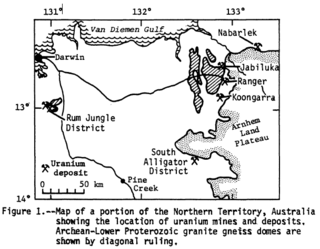
Kakadu National Park is a protected area in the Northern Territory of Australia, 171 km (106 mi) southeast of Darwin. It is a World Heritage Site. Kakadu is also gazetted as a locality, covering the same area as the national park, with 313 people recorded living there in the 2016 Australian census.

Alligator Rivers is the name of an area in an Arnhem Land region of the Northern Territory of Australia, containing three rivers, the East, West, and South Alligator Rivers. It is regarded as one of the richest biological regions in Australia, with part of the region in the Kakadu National Park. It is an Important Bird Area (IBA), lying to the east of the Adelaide and Mary River Floodplains IBA. It also contains mineral deposits, especially uranium, and the Ranger Uranium Mine is located there. The area is also rich in Australian Aboriginal art, with 1500 sites. The Kakadu National Park is one of the few World Heritage sites on the list because of both its natural and human heritage values. They were explored by Lieutenant Phillip Parker King in 1820, who named them in the mistaken belief that the crocodiles in the estuaries were alligators.

Big Bill Neidjie, nicknamed "Kakadu Man", was the last surviving speaker of the Gaagudju language, an Aboriginal Australian language from northern Kakadu, after which Kakadu National Park is named. He was an elder of the Gaagudju people and a custodian of the land, who cared deeply about preserving his culture and land.

Gunbalanya is an Aboriginal Australian town in west Arnhem Land in the Northern Territory of Australia, about 300 kilometres (190 mi) east of Darwin. The main language spoken in the community is Kunwinjku. At the 2021 Australian census, Gunbalanya had a population of 1,177.
Ngomburr, also spelt Ngumbur, is an extinct Australian Aboriginal language. It has sometimes been assumed to be a dialect of Umbugarla, but it is poorly attested; the only evidence to go on is that neighbouring peoples reported that it was similar to Umbugarla, as well as some sentences and vocabulary. It was spoken to the west of the South Alligator River, between the Ga'baarlgu and the South Alligator River, in Kakadu, Northern Territory.

Giimbiyu is an extinct Aboriginal Australian language isolate once spoken by the Giimbiyu people of northern Australia.

The Iwaidjan or Yiwaidjan languages are a small family of non-Pama–Nyungan Australian Aboriginal languages spoken in the Cobourg Peninsula region of Western Arnhem Land.

The Kunwinjku people are an Australian Aboriginal people, one of several groups within the Bininj people, who live around West Arnhem Land to the east of Darwin, Northern Territory. Kunwinjku people generally refer to themselves as "Bininj" in much the same way that Yolŋu people refer to themselves as "Yolŋu".
Alawa (Galawa) is a moribund Indigenous Australian language spoken by the Alawa people of the Northern Territory. In 1991, there were reportedly 18 remaining speakers and 4 semi-speakers.
Uwinymil, also spelt Uwinjmil and also known as Awinmul, is an extinct Australian Aboriginal language of Arnhem Land in the Northern Territory of Australia.

The Macro-Gunwinyguan languages, also called Arnhem or Gunwinyguan, are a family of Australian Aboriginal languages spoken across eastern Arnhem Land in northern Australia. Their relationship has been demonstrated through shared morphology in their verbal inflections.
The Bininj are an Aboriginal Australian people of Western Arnhem land in the Northern Territory. The sub-groups of Bininj are sometimes referred to by the various language dialects spoken in the region, that is, the group of dialects known as Bininj Kunwok; so the people may be named the Kunwinjku, Kuninjku, Kundjeyhmi (Gundjeihmi), Manyallaluk Mayali, Kundedjnjenghmi and Kune groups.
The Gadjalivia were an indigenous Australian people of Arnhem Land in the Northern Territory. They are now regarded as extinct.
The Dalabon or Dangbon are an Australian Aboriginal people of the Northern Territory.
The Gungorogone are an indigenous Australian people of the Northern Territory.
The Ngardok were an indigenous Australian people of the Northern Territory. Nothing is known of the language, which has been extinct since about WW2.
The Gaagudju, also known as the Kakadu, are an Aboriginal Australian people of the Northern Territory. There are four clans, being the Bunitj or Bunidj, the Djindibi, and two Mirarr clans. Three languages are spoken among the Mirarr or Mirrar clan: the majority speak Kundjeyhmi, while others speak Gaagudju and others another language.
The Marra, formerly sometimes referred to as Mara, are an Aboriginal Australian people of the Northern Territory.
The Ngormburr, also known as Murumburr and other variants, are an Aboriginal Australian people of the Northern Territory.
The Limilngan, also known by the exonym Minitja and Buneidja, are an Aboriginal Australian people of the Northern Territory. Earlier ethnologists such as Norman Tindale referred to the group as Puneitja or variants of that spelling.








